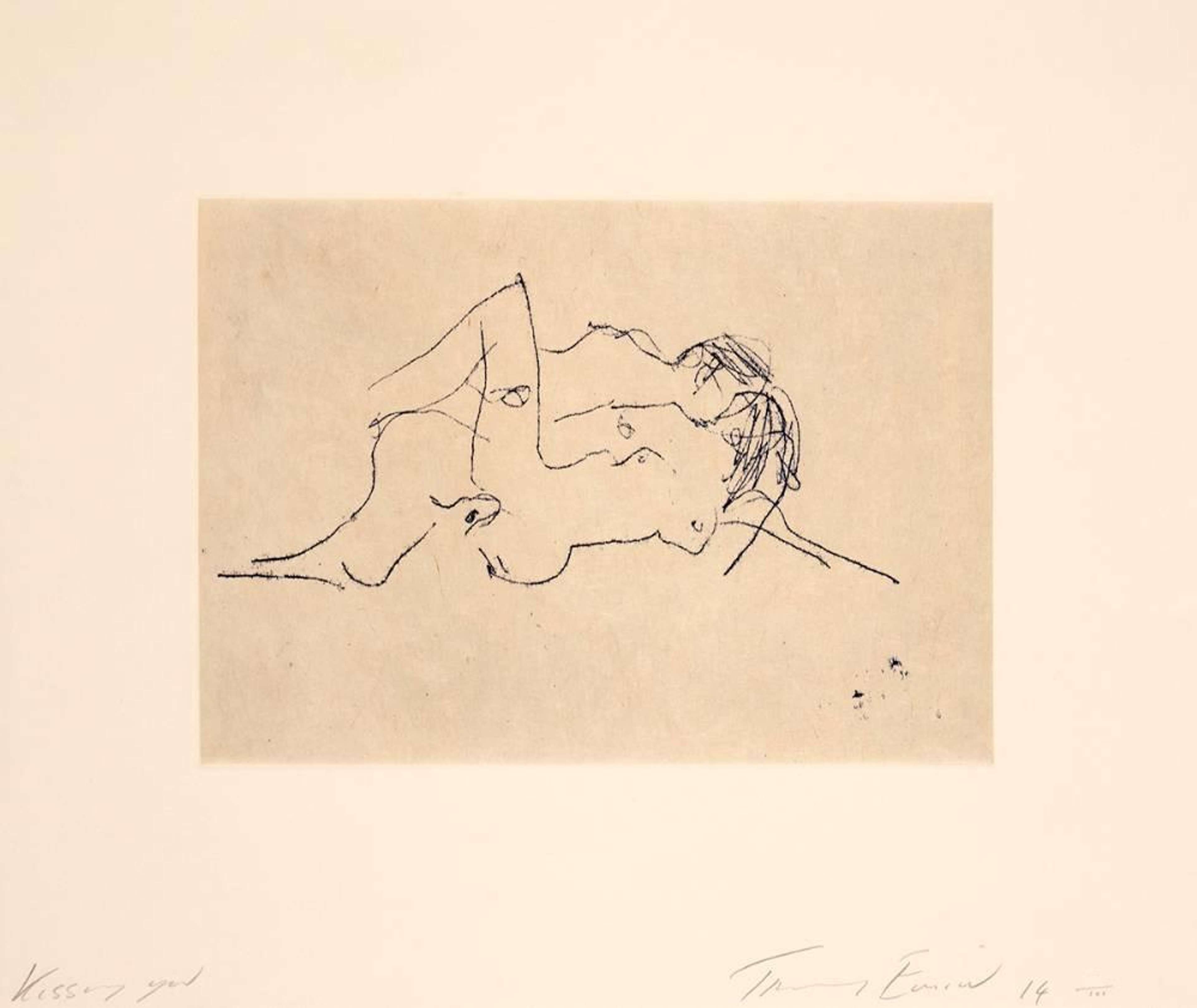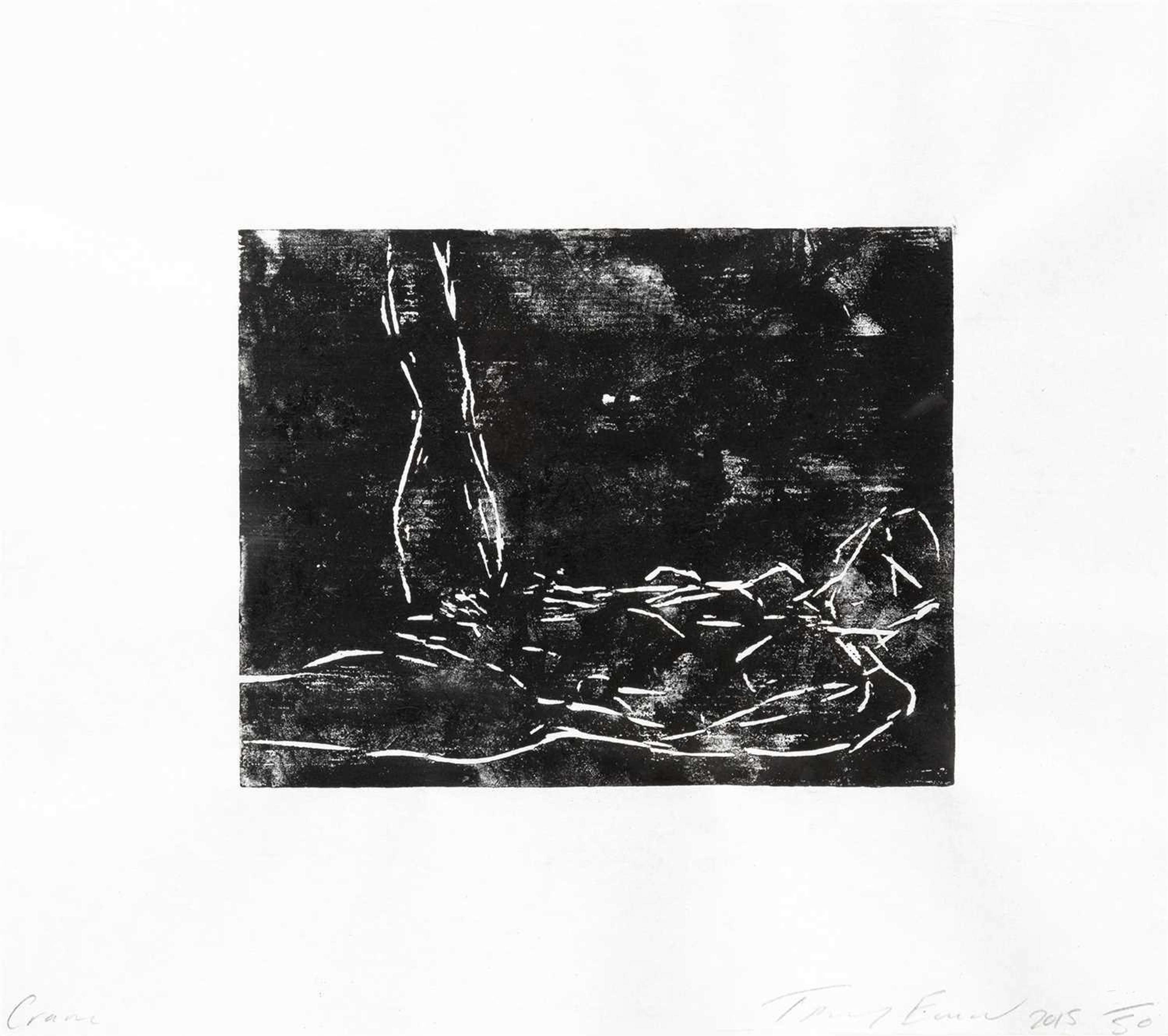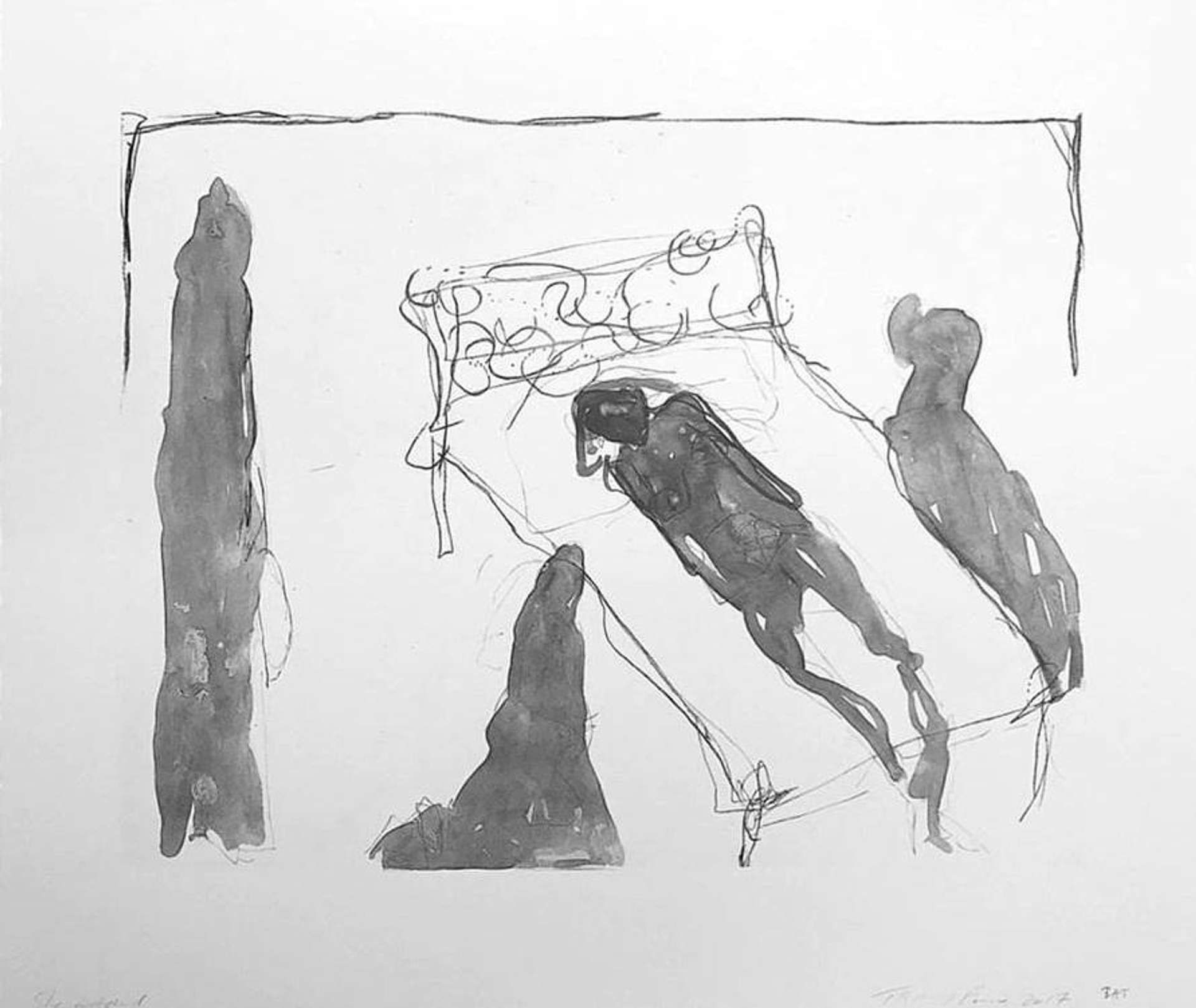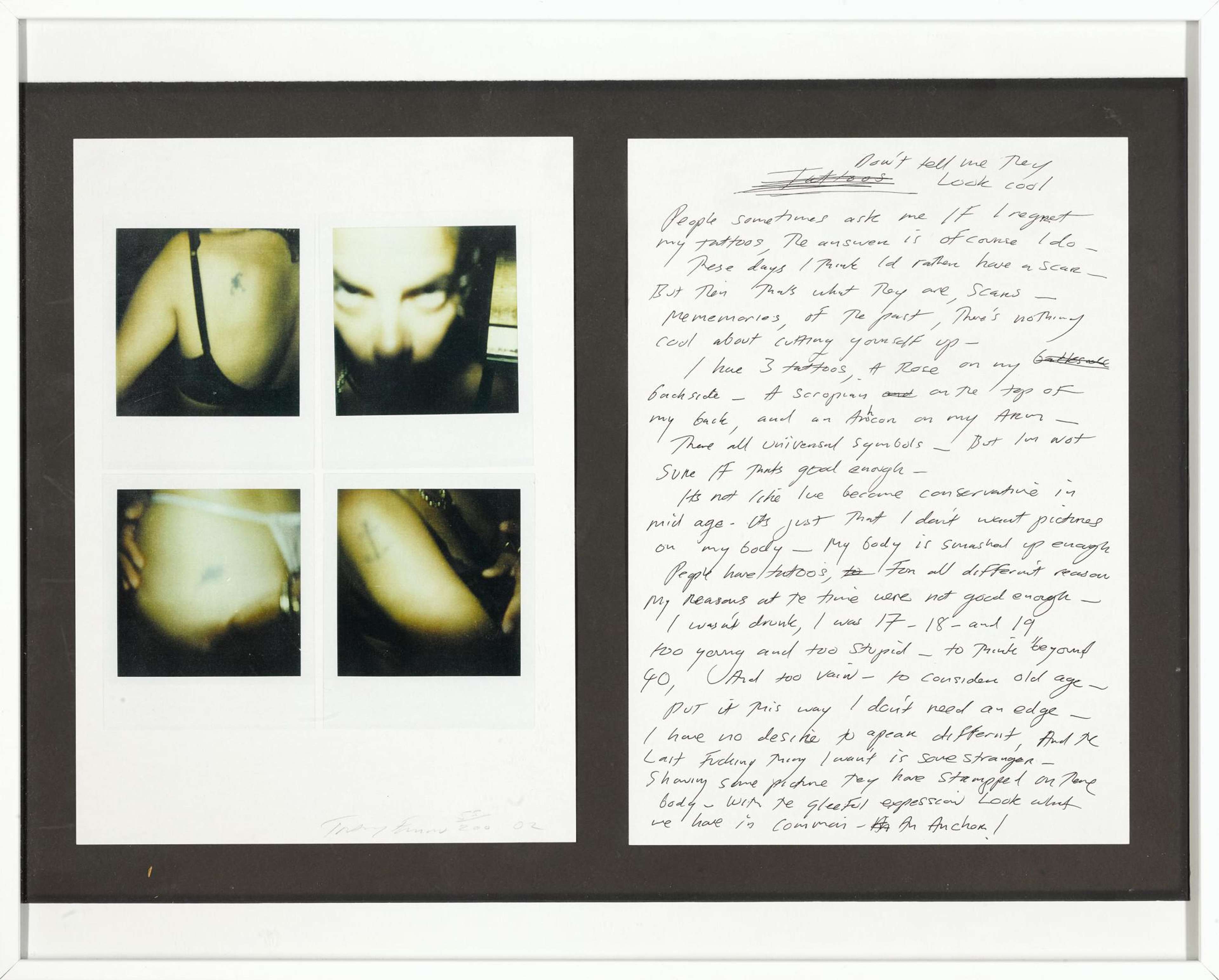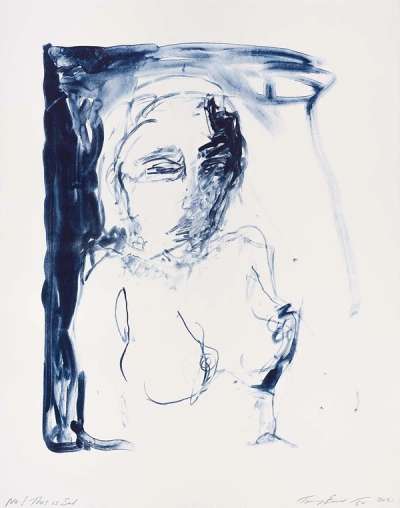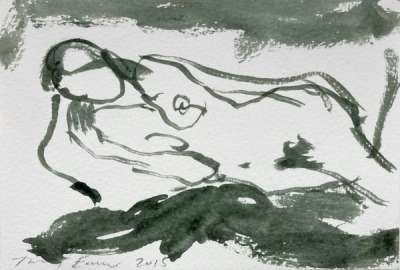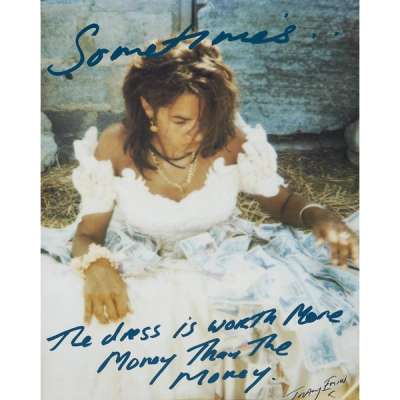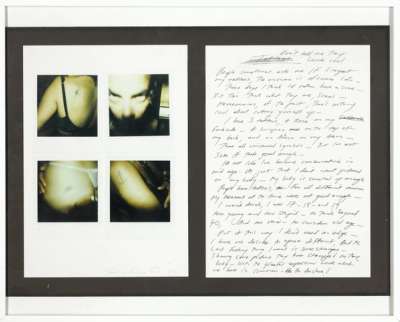 Image © Hang-Up Gallery / You Held My Face © Tracey Emin 2018
Image © Hang-Up Gallery / You Held My Face © Tracey Emin 2018
Tracey Emin
141 works
Tracey Emin has consistently defied conventions and boundaries with her audacious creations. Born in 1963 in London, she rose to prominence during the 1990s as a member of the Young British Artists. Over the decades, her work has spanned various mediums, each piece reflecting her personal experiences. Emin's art is a confluence of the raw and refined, offering viewers an unfiltered lens into her world. From installations and paintings to writings and drawings, her oeuvre is a testament to her prowess, resilience, and unwavering commitment to authentic self-expression.
A is for Autobiographical Art
Tracey Emin is best known for her autobiographical and confessional art. Often drawing directly from her life experiences, her art becomes a canvas of emotions, memories, and intimate revelations. From the stories of her challenging childhood in Margate to the complexities of love, relationships, and her own self-image, Emin bravely channels her life into her pieces. This profound blend of personal history with artistic expression not only makes her work deeply relatable but also challenges conventional boundaries in art, allowing viewers to connect with her on an emotive level beyond the art they see.
B is for Bed
In 1998, Tracey Emin unveiled My Bed, a bold installation at the Tate Gallery that remains one of her most iconic works. The piece presents her actual unmade bed, with everyday debris—emotional or otherwise. Beyond its shock value, the installation invited viewers into Emin's personal realm, during a real-time emotional break. In lieu of support, she was met with criticism that helped earn her reputation as “Britain’s bad girl.”
C is for Confrontational
Emin's art has often been described as confrontational, raw, and deeply personal. Frequently described as confrontational, her pieces challenge both viewer and cultural norms alike. Emin does not shy away from displaying the grittier, unfiltered facets of her life, using her art as an arena to confront personal traumas, societal expectations, and the often complex nature of femininity. This raw presentation can be both jarring and deeply moving, inviting audiences to reflect on their own experiences and biases. Through her fearless transparency, Emin establishes a dialogue about authenticity, pain, and the human experience in contemporary art.
D is for Drawing
Beyond her installations and sculptures, Emin has a substantial body of drawings. Her drawings, which often blur the boundaries between visual art and personal diary, capture the thoughts and desires of the artist. Emin's choice to include scribbles and notes reveals a need to communicate the unvarnished truth of her experiences, without the shield of artistic abstraction. Her Nude Drawings specifically illustrate just how intimate and impactful rough sketches with minimal texts can be.
E is for Everyone
Everyone I Have Ever Slept With Far from being a simple list of lovers, Everyone I Have Ever Slept With 1963–1995 encompasses all who shared her bedspace, be it platonically or romantically. Housed within a tent, this artwork is both a sanctuary and an exposition, sheltering memories while laying them bare for public scrutiny. Emin challenges traditional ideas about intimacy, pushing the audience to consider the diverse spectrum of close connections we form throughout our lives.
F is for Feminism
Emin’s oeuvre is rich with feminist discourse, serving as an unfiltered reflection on the complexities of womanhood in contemporary society. Her art is not just a critique but instead, a collection experiences, vulnerabilities, and the broader struggles women face. By drawing on intimate aspects of her life, Emin amplifies the shared experiences of countless women. They navigate issues of identity, sexuality, and societal expectations, all while reminding the world that the personal is indeed political.
G is for Grit
Emin's journey in the art world speaks volumes to her unyielding grit and determination. From the early adversities she faced to the criticism that often surrounded her provocative works, Emin has consistently pushed the limits. Rather than shying away from controversy, she embraced it, using it as fuel to further her artistic expression. This resilience and relentless pursuit of authenticity are what have solidified her status, illustrating that true artistry often lies in the courage to remain genuine in the face of adversity.
H is for Honours
In 2013, the art world and Britain at large recognised Emin’s undeniable impact on visual arts when she was appointed CBE (Commander of the Order of the British Empire). This honour was not just an acknowledgment of her creative prestige, but a nod to her ability to challenge, redefine, and expand the boundaries of art. Her fearless approach, both in medium and message, has influenced the landscape of contemporary art, proving that genuine reflection and raw vulnerability are, in themselves, acts of commendable bravery.
 Image © Google Arts and Culture / Psycho Slut © Tracey Emin
Image © Google Arts and Culture / Psycho Slut © Tracey EminI is for Installations
Emin's art installations serve as visceral manifestations of her innermost feelings and memories. Recognised globally, they have an uncanny ability to resonate with wide audiences, often igniting impassioned media discussions and public dialogues. Whether it's her textile work, neon pieces or bedroom, Emin crafts spaces that echo the rawness of life's experiences. In these installations, viewers are invited not just to observe but to feel, to question, and to introspect.
J is for Journal
Emin has always seen her art as a visual journal, an unfiltered reflection of her life. Every piece she creates tells a story, giving insight into her thoughts, feelings, and memories. This journal-like approach to art gives viewers a rare opportunity to trace the narrative of her life, making them not just observers but participants in her deeply personal voyage. Emin's commitment to authenticity ensures that each artwork serves as a diary page, capturing moments of vulnerability, joy, pain, and reflection.
K is for Kent
Although born in Croydon, it was Margate in Kent that cradled her formative years. The juxtaposition of the town's rugged beauty and its underlying melancholy seeps into her work. Whether it's the vast horizons that speak to endless possibilities or the nostalgic echoes of a childhood spent by the seaside, Margate remains a consistent muse for Emin. Through her pieces, one can feel the ebb and flow of the tides, and the town's profound influence on her perception of home and identity.
L is for Literature
Emin's pen has proven to be as evocative as her visual art. Looking into her literature, she's written multiple books that serve as both memoir and manifesto. Each page brings readers closer to her world, sharing intimate tales of love, loss, and artistic pursuit. Her writings provide a candid backdrop to her artworks, illuminating the experiences and emotions that shape her creations. Works like Strangeland, When I Think About Sex, and My Photo Album helps Emin build a narrative bridge, connecting her life with those willing to traverse its intricate threads.
M is for Major Exhibitions
Since the early 90s, Emin's exhibitions have been a locus of both controversy and admiration. A tour de force in contemporary art, her shows at esteemed venues like the White Cube gallery and the Royal Academy of Arts have consistently evoked strong reactions. These exhibitions, each a unique chapter in her artistic journey, lay bare the soul and psyche of a woman unafraid to confront societal taboos. A retrospective of her career showcases a fearless artist challenging conventions, prompting viewers to question their own perspectives and the confines of the art world itself.
N is for Neon
Neon, with its ethereal glow and urban resonance, finds a unique voice in Emin's hands. Her neon artworks, radiating a luminous intensity, go beyond the aesthetic, encapsulating potent messages about love, loss, and existence. The Neons become sculptures; they are confessions, affirmations, and reflections that illuminate our lives just as much as Emins. Her choice to use neon—a medium often associated with commercial signage—elevates everyday sentiments to high art, showcasing her genius for melding medium and message in unexpected ways.
O is for Olympics
In 2012, Emin designed a limited-edition poster for the London Olympics. Her limited-edition poster for the event captured the spirit of London - a blend of modernity and timeless tradition. It also signalled Emin’s universal appeal and her place in contemporary British iconography. The poster serves as a reminder of how art and sport can unify a nation, reflecting shared values, aspirations, and cultural pride.
P is for Professor
Emin was the Professor of Drawing at the Royal Academy until 2021. Teaching at such a prestigious institution was both an acknowledgment of her skills and her ability to influence the next generation of artists. Through this role, Emin bridged the gap between the avant-garde and traditional artistry, demonstrating that contemporary voices have an essential place in guiding future talents. It exemplifies her commitment not just to her own art but to nurturing the growth of others.
 Image © Kent Online / Like A Cloud Of Blood © Tracey Emin 2022
Image © Kent Online / Like A Cloud Of Blood © Tracey Emin 2022Q is for Quotes
Emin's art often resonates due to its deep-seated authenticity, and her thought-provoking quotes are no exception. These words, frequently woven into her artworks, offer glimpses into her soul and thought processes. They challenge viewers, prompting introspection and a deeper engagement with the pieces. Emin’s ability to articulate complex emotions and experiences in simple phrases adds layers of depth to her work. These quotes don't just embellish; they are the essence, providing context and amplifying the emotional resonance of her compositions.
R is for Royal Academy
In 2007, Emin’s election to the Royal Academy of Arts was groundbreaking. As one of the youngest and few female members to be chosen, her inclusion marked a shift in the art world's acceptance and celebration of contemporary and, at times, contentious voices. The Academy, with centuries of tradition, recognised Emin’s undeniable impact on the modern art landscape. Her election wasn't just a personal triumph but a nod to the evolving dynamics and widening horizons of the global art community.
S is for Stuckism
Born out of opposition to the Turner Prize nominees, particularly Emin and Damien Hirst, Stuckism was more than just critique; it became an art movement in its own right. While it began as a rejection of conceptual art in favour of figurative painting, the discourse around Stuckism underscored Emin's influence.
 Image © Widewalls / The Tent Interior, Everyone I Have Ever Slept With 1963–1995 © Tracey Emin 1995
Image © Widewalls / The Tent Interior, Everyone I Have Ever Slept With 1963–1995 © Tracey Emin 1995T is for Turner Prize
The Turner Prize nomination in 1999 propelled Tracey Emin into the limelight, primarily for her piece My Bed. This artwork, filled with personal items and signifying the aftermath of a traumatic period in her life, invited viewers into her most intimate space. The nomination was polarising; some hailed it as genius, while others dismissed it and wouldn’t dare consider it art. Regardless of stance, it's undeniable that the nomination marked a pivotal moment in Emin's career.
U is for Unapologetic
Emin’s artistry is characterised by its unapologetic nature. Whether she’s laying bare her personal experiences or challenging societal norms, she has consistently defied expectations without seeking validation. It’s this approach that has earned her both critique and admiration. Yet, it's this very audacity that makes her work so compelling and keeps us intrigued. Emin's unapologetic stance not only defines her work but has also paved the way for other artists to embrace authenticity over conformity.
V is for Video Art
Emin has dabbled in video art, including the notable piece Why I Never Became a Dancer which tells a story from her adolescence. In this medium, her works powerfully depict her challenging youth in Margate, blending tales of hardship with dreams of finding freedom through dance. However, this piece is more than a recollection of trials; it represents Emin's audacious act of seizing back her story. Through it, Emin doesn't just narrate her past; she showcases the transformative might of art, turning anguish into resilience and rebellion
W is for Workshops
Throughout her career, Tracey Emin has embraced the transformative power of workshops. In her formative years, they provided a space where she honed her craft and exchanged ideas. Later, she began offering them, championing continuous learning and nurturing emerging talents. Emin’s commitment extends to her creation of TKE STUDIOS, a gallery space, artist studios, and residency that embodies her ethos. Here, workshops transcend mere skill development; they're spaces of free expression and the collective exchange of visionary thought.
X is for X-rated
Some of Emin’s work has been labelled as explicit due to its candid exploration of sexuality and personal experiences. Emin has never shied away from presenting the raw, unfiltered facets of humanity in her work. However, to dismiss them as X-rated misses the point. Emin’s audacity in laying bare her vulnerabilities, traumas, and passions serves as a challenge to societal taboos and a call for authentic self-expression. Her candidness, rather than being gratuitous, is a testament to her commitment to genuine storytelling and the breaking down of both creative and societal barriers.
Y is for You
The Last Great Adventure Is You, presented at White Cube in 2014, stands as one of Emin's most acclaimed collections. The title itself mirrors the personal journey of self-exploration, where Emin revisits the themes of the female self and body. By describing the collection as "about rites of passage, of time and age," she draws parallels to her earlier nude monoprints. Yet, there’s a discernible evolution: the strokes are surer, the lines more deliberate. This progression in her mark-making highlights her maturity as an artist, reflecting a reconciliation with her own identity.
Z is for Zeitgeist
Emin captures the zeitgeist of her times. Her works, while deeply personal, resonate with broader cultural and societal themes. Whether it's challenging conventions, highlighting the complexities of modern relationships, or commenting on the ever-shifting boundaries of art, Emin's pieces serve as a mirror to society's soul. Through her work, she not only reflects the times but also shapes and challenges contemporary thought and discourse.


